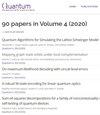Block encoding bosons by signal processing
IF 5.1
2区 物理与天体物理
Q1 PHYSICS, MULTIDISCIPLINARY
引用次数: 0
Abstract
Block Encoding (BE) is a crucial subroutine in many modern quantum algorithms, including those with near-optimal scaling for simulating quantum many-body systems, which often rely on Quantum Signal Processing (QSP). Currently, the primary methods for constructing BEs are the Linear Combination of Unitaries (LCU) and the sparse oracle approach. In this work, we demonstrate that QSP-based techniques, such as Quantum Singular Value Transformation (QSVT) and Quantum Eigenvalue Transformation for Unitary Matrices (QETU), can themselves be efficiently utilized for BE implementation. Specifically, we present several examples of using QSVT and QETU algorithms, along with their combinations, to block encode Hamiltonians for lattice bosons, an essential ingredient in simulations of high-energy physics. We also introduce a straightforward approach to BE based on the exact implementation of Linear Operators Via Exponentiation and LCU (LOVE-LCU). We find that, while using QSVT for BE results in the best asymptotic gate count scaling with the number of qubits per site, LOVE-LCU outperforms all other methods for operators acting on up to $\lesssim11$ qubits, highlighting the importance of concrete circuit constructions over mere comparisons of asymptotic scalings. Using LOVE-LCU to implement the BE, we simulate the time evolution of single-site and two-site systems in the lattice $\varphi^4$ theory using the Generalized QSP algorithm and compare the gate counts to those required for Trotter simulation.用信号处理对玻色子进行分组编码
块编码(BE)是许多现代量子算法中至关重要的子程序,包括那些用于模拟量子多体系统的近最佳缩放算法,这些算法通常依赖于量子信号处理(QSP)。目前,构造BEs的主要方法是一元线性组合(LCU)和稀疏oracle方法。在这项工作中,我们证明了基于qsp的技术,如量子奇异值变换(QSVT)和单一矩阵的量子特征值变换(QETU),本身可以有效地用于be实现。具体来说,我们给出了几个使用QSVT和QETU算法的例子,以及它们的组合,以块编码晶格玻色子的哈密顿算子,这是模拟高能物理的重要组成部分。我们还介绍了一种基于通过幂运算和LCU (LOVE-LCU)的线性算子的精确实现的简单的BE方法。我们发现,虽然将QSVT用于BE的结果是随着每个站点的量子位数的增加而产生最佳的渐近门计数缩放,但LOVE-LCU在作用于$\lesssim11$量子位的算子上优于所有其他方法,这突出了具体电路结构比仅仅比较渐近缩放的重要性。利用LOVE-LCU实现该BE,我们使用广义QSP算法在晶格$\varphi^4$理论中模拟单点和双点系统的时间演化,并将门数与Trotter模拟所需的门数进行比较。
本文章由计算机程序翻译,如有差异,请以英文原文为准。
求助全文
约1分钟内获得全文
求助全文
来源期刊

Quantum
Physics and Astronomy-Physics and Astronomy (miscellaneous)
CiteScore
9.20
自引率
10.90%
发文量
241
审稿时长
16 weeks
期刊介绍:
Quantum is an open-access peer-reviewed journal for quantum science and related fields. Quantum is non-profit and community-run: an effort by researchers and for researchers to make science more open and publishing more transparent and efficient.
 求助内容:
求助内容: 应助结果提醒方式:
应助结果提醒方式:


